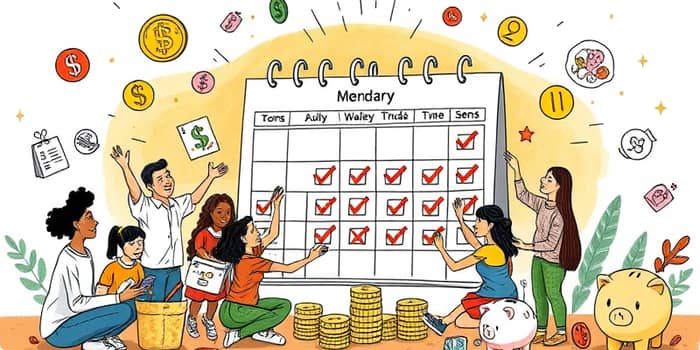Feeling overwhelmed by impulse buys? A structured no-spend challenge can be the catalyst you need to transform your relationship with money. By committing to pause nonessential spending, you’ll discover the power of intention and build stronger financial discipline.
What Is a No-Spend Challenge?
A no-spend challenge is a dedicated period during which you stop all discretionary purchases. Essentials—housing, groceries, utilities, transportation—remain unchanged. The aim is to identify and eliminate unnecessary spending patterns that quietly drain your resources.
Rather than feeling deprived, participants often report a sense of accomplishment and tangible financial progress by the end of the challenge.
The Benefits: Short-Term, Long-Term, and Mental Gains
- Immediate increase in savings: Redirect dozens—even hundreds—of dollars into your emergency fund or debt payments.
- Improved spending habits: Breaking cycles of impulsive purchases leads to lasting budgeting skills.
- Reduced financial stress: Simplifying expenses can calm your mind and boost confidence.
- Heightened emotional awareness: Tracking urges helps you see when you spend out of boredom or anxiety.
These benefits compound over time. What starts as a one-week experiment can lay the foundation for life-changing financial habits.
Choosing the Right Timeframe
Challenge durations vary. Beginners might test the waters over a weekend, while seasoned savers could tackle a full month or more. The optimal length is ambitious yet realistic—often thirty days.
Longer timeframes can yield greater savings but may require deeper planning and flexibility.
Crafting Your Personal Rules
No two budgets are identical. To make the challenge effective, you must define what counts as essential versus nonessential spending. Consider using categories to guide you:
Essentials might include groceries, rent, utilities, prescription medications, and transports. Nonessentials could cover dining out, streaming subscriptions, impulse shopping, and entertainment.
You may choose to create exceptions for social obligations or existing commitments. The key is clarity: clear definitions prevent confusion and reduce the temptation to cheat.
Preparing and Planning for Success
Preparation increases your odds of success. Here’s how to set yourself up for a smooth challenge:
- Stock your pantry with meal-prep ingredients to avoid last-minute takeout.
- Research free or low-cost activities—hiking, library visits, home workouts—to replace paid entertainment.
- Cancel unused subscriptions and pause memberships temporarily.
- Set specific, measurable goals: “Save $300 in 30 days” or “Pay down $200 of credit card debt.”
By tackling these tasks ahead of time, you’ll reduce friction and stay committed even when temptations arise.
Staying Accountable and Tracking Progress
Visibility drives motivation. Choose a tracking method that resonates with you—digital apps, spreadsheets, or printable charts. Check in daily, and celebrate small wins.
Consider partnering with a friend or joining an online community for extra support. Sharing your journey fosters meaningful accountability and keeps you motivated on tough days.
Redirecting Savings and Reflecting
When the challenge concludes, calculate your total savings. Redirect the money toward your stated goal—paying off debt, building an emergency fund, or investing.
Reflection is equally important. Ask yourself:
- What temptations were hardest to resist?
- Which new habits felt sustainable?
- Where can I maintain restraint without feeling deprived?
This introspection transforms a temporary experiment into lasting financial change.
Common Pitfalls and How to Avoid Them
Even the most determined participants can stumble. Watch out for these traps:
- Setting overly strict rules that lead to burnout.
- Rewarding yourself with a spending spree once the challenge ends.
- Ignoring emotional triggers and not planning healthier outlets.
Flexibility and forgiveness are essential. If you slip up, view it as data, not failure, and recommit immediately.
Keeping Habits Beyond the Challenge
The real victory lies in sustaining positive changes. After your challenge, you might:
• Continue avoiding one or two discretionary categories permanently.
• Schedule mini-challenges—weekend or week-long—quarterly throughout the year.
• Automate savings so that a portion of your paycheck moves directly into a separate account.
Each of these practices cements mindful and intentional spending as part of your everyday life.
Alternatives and Custom Options
If a strict no-spend feels daunting, experiment with variations:
• A “low-spend challenge” that caps discretionary expenses at a small fixed amount.
• The “100 envelopes” method, saving random amounts in envelopes daily to build up a surprise lump sum.
These alternatives allow customization based on personality, budget constraints, and lifestyle.
By following these guidelines—setting clear goals, planning ahead, tracking progress, and reflecting afterward—you can create a no-spend challenge that not only works but transforms your financial life. Embrace the journey, learn from each moment, and celebrate the empowerment that comes from taking control of your spending.
References
- https://www.pnc.com/insights/personal-finance/save/no-spend-challenge.html
- https://www.johnsonfinancialgroup.com/resources/blogs/your-financial-life/the-no-spend-month-challenge-the-ultimate-reset-for-your-finances/
- https://www.fidelity.com/learning-center/personal-finance/no-spend-challenge
- https://financialtips.bankatpeoples.com/money-management/budgeting/article/the-no-spend-challenge
- https://www.rocketmoney.com/learn/personal-finance/no-spend-challenge
- https://www.experian.com/blogs/ask-experian/how-to-do-no-spend-challenge/
- https://www.lifewithlessmess.com/no-spend-january/
- https://www.verywellmind.com/i-tried-no-spend-challenge-11738152










